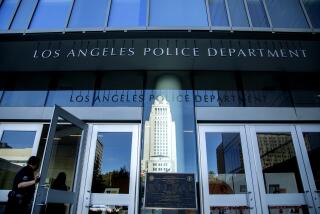D.C. Cracks Down During Crime Lull
- Share via
WASHINGTON — Politicians in Washington and its suburbs, eager to position themselves on the side of law and order, joined local and federal law enforcement officials Friday in taking a stand against the crime spike that has alarmed the area.
Trouble is, there is no overall crime spike. It’s more of a “blip,” says William F. McDonald, codirector of Georgetown University Law Center’s Institute of Criminal Law and Procedure.
Although a man was slain this month in the affluent Georgetown neighborhood, at the current pace there would be fewer homicides in 2006 than in any of the last 20 years.
There have been five armed robberies on the National Mall this summer, but overall crime in the District of Columbia is at its lowest in at least a decade.
“It’s a big decline,” McDonald said. “It’s been on the decline since 1992.”
There has been an uptick this year in certain categories: Robberies have increased 14% over last year, and arrests for weapons offenses are up 27%.
“Our goal is to reduce violent crime in the city by 50% over the next 30 days in every district of the city,” Washington Mayor Anthony Williams said Friday in announcing a new violent crime task force of local and federal law enforcement agencies.
Strategies include a stronger police presence and closed-circuit TV cameras in some areas, and changing the youth curfew from midnight to 10 p.m.
Once crime is down, said Police Chief Charles Ramsey, the question is, “How do we keep it there?”
The answer might be beyond the reach of law enforcement.
“There are sociological factors that the criminal justice system really doesn’t touch that drive crime: economics, education levels, changes in the makeup of a population,” said James J. McDonough, director of the Virginia Criminal Justice Research Center.
Even weather can influence crime, he said, noting that illegal activity typically drops in the winter and peaks in the summer.
And data can be misleading, he said. For example, higher arrest numbers might not reflect increased crime, but a shift in resources to apprehend criminals.
Crime nationwide surged during the crack epidemic and drug wars of the 1980s, leveled off in the early ‘90s, and steadily and dramatically declined for the next decade.
Preliminary FBI data show a 2.5% rise in violent crime in the U.S. from 2004 to 2005, which Washington officials fear eventually will be mirrored here, as it was two decades ago.
“When crime gets out of control in the country, it takes longer for it to come down in the district,” said Delegate Eleanor Holmes Norton (D-D.C.). “There is a staying quality to crime once it goes up here.”
Republican Rep. Frank R. Wolf, from Washington’s Virginia suburbs, said he would support additional federal funding for crime control in the district.
Although officials cannot control the economic or cultural factors behind some crimes, they can focus on crimes of opportunity, like the Mall robberies.
“The people who did it ... saw an opportunity that they thought would allow them to commit a crime and get away with it,” McDonald said, adding that increased patrols can deter criminals by increasing their risk of getting caught.
More to Read
Sign up for Essential California
The most important California stories and recommendations in your inbox every morning.
You may occasionally receive promotional content from the Los Angeles Times.










